2 Classifying Instruments
Matthew Mihalka
You may be familiar with the standard families of instruments in a symphony orchestra, a model that is frequently used to classify Western instruments. The symphony orchestra is usually divided into strings (played with a bow or plucked, such as violins and cellos), woodwinds (instruments traditionally made from wood where air is blown over a sharp edge, such as oboes and flutes), brass (metal instruments played with vibrating lips, such as trombones and trumpets), and percussion instruments (instruments where something is struck to create sound, such as drums and marimbas). While the model of the symphony orchestra provides a starting point, it cannot be used to fully classify the diversity of different types of instruments that are found throughout the world, or even just within Western countries.
A new system of instrument classification was developed by ethnomusicologists Erich Moritz von Hornbostel and Curt Sachs in 1914. The Hornbostel-Sachs system is still in use to the present day and is used throughout the course of this text. In the Hornbostel-Sachs system instruments are classified depending on what is vibrating to create sound, as all sound is created by vibration. The classification of instruments in a symphony orchestra shares some similarities with the Hornbostel-Sachs system, but also some key points of divergence. The Hornbostel-Sachs system divides instruments into four categories, described in greater detail below:
- MEMBRANOPHONES – drums
- IDIOPHONES – the body of the instrument vibrates to create sound
- CHORDOPHONES – string instruments
- AEROPHONES – air is primarily used to create sound
- ELECTROPHONES – electronic instruments
MEMBRANOPHONES
In the Hornbostel-Sachs system, percussion instruments (where an instrument is struck to create sound) are split into membranophones and idiophones. With membranophones a membrane, usually a drumhead, vibrates to create sound. The membranes are typically made of animal skins or synthetic materials that are stretched over the base of the drum. Drums can be found in all parts of the world and can be struck in a variety of fashions, including with bare hands, mallets, and sticks.
Djembe – An irregular hourglass shaped drum from Western Africa played with the hands.
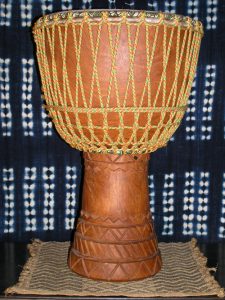
“Traditional Djembe” by Nata Vellinga is licensed under CC BY-SA 3.0
Dhol – A double-headed southwest Asian drum that is played with sticks
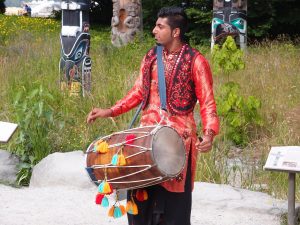
“Dhol Player” by Guilhem Vellut is licensed under CC BY 2.0
IDIOPHONES
Idiophones are the other classification of percussion instruments in the Hornbostel-Sachs system. Unlike membranophones, where just a membrane is vibrating to create sound, with idiophones the instrument’s body itself vibrates to create sound. Think of a set of orchestral cymbals, which vibrate when struck against one another, or even a cymbal as part of a drum set that vibrates once hit with a drum stick. Idiophones can be classified into subcategories, such as:
- Instruments that are struck against one another (such as cymbals)
- Instruments that are struck by a non-vibrating object like a mallet (gongs)
- Instruments that are shaken (rattles)
- Instruments that are scraped (guiro – notched or ridged instrument played with a stick)
- Instruments that are plucked (mbira – the thumb piano instrument of the Shona people of Zimbabwe), and instruments that are rubbed (such as rubbing your fingers around the rim of a glass).
CHORDOPHONES
Chordophones are instruments that generate sound through the vibration of a string, whether it is plucked, bowed, or struck. This classification also includes many keyboard instruments, such as a piano where a hammer strikes a string in the body of the instrument to create sound.
Erhu – Two-string bowed fiddle from China
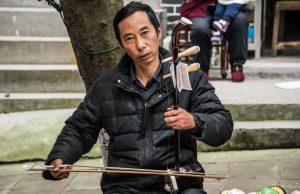
“Erhu Musician” by Ted McGrath is licensed under CC BY-NC-SA 2.0
AEROPHONES
Aerophones include any instrument where sound is primarily generated by vibrating air. Included in this category are both woodwind and brass instruments, as well as other reed instruments and flutes.
Harmonium – Common in many Indian genres, the harmonium consists of a bellows that is pumped with one hand while the other hand plays a keyboard. Sound is generated by air sent over reeds.
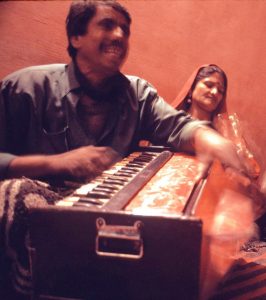
“Harmonium” by Joe Morris is licensed under CC BY-SA 3.0 and CC BY 2.5
Andean Panpipes (Siku) – Panpipe instruments consist of pipes of different lengths, and pitches, fixed together. They are played by blowing air across the top of each pipe. The linked example is from the Andes, a mountain range that runs along the western side of South America, where such instruments have been traced by thousands of years.
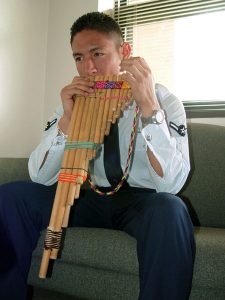
“Zampoña” is licensed under Public Domain.
ELECTROPHONES
Electrophones are a category of instruments that was not included in the originally devised Hornbostel-Sachs system. They are instruments where sound is created through electric means, such as synthesizers, electric organs, and theremins. Frequently, it is a speaker connected to the instrument that vibrates to create sound.
Theremin – An electronic instrument where there is not physical contact between the performer and the instrument itself. The performer’s hands instead are placed by two antennas, one dedicated to pitch and the other volume. The instrument is commonly used for movie scores, especially for older science fiction films.
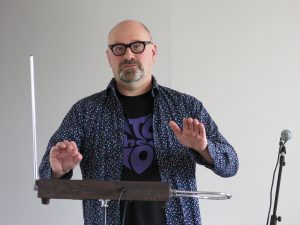
“John Chrisstoffels: The Novel and the Theremin” by Christchurch City Libraries is licensed under CC BY-NC-SA 2.0
Instrument classification where the sound produced comes from an attached membrane
Instrument classification where the sound produced comes from the whole instrument
Instrument classification where the sound produced comes from a single or series of strings
Instrument classification where the sound produced comes from air moving over or through the instrument
Instrument classification where the sound produced comes from an electronic device

